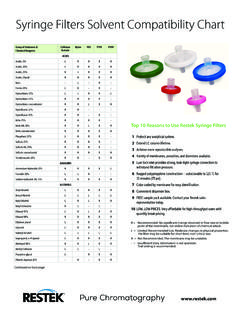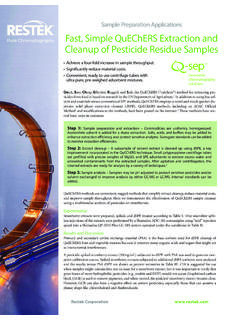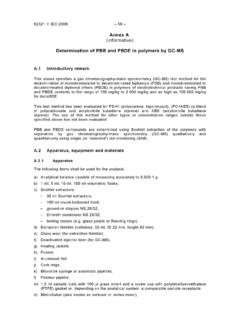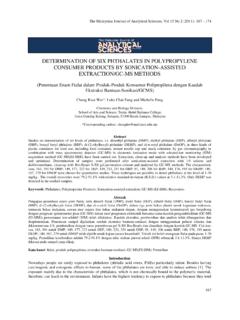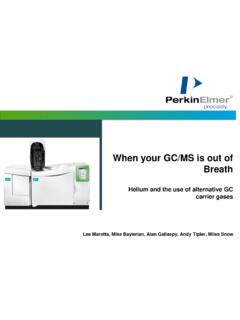Transcription of Guide to GC Column Selection and Optimizing …
1 IDWHICH Column DO I NEED?STATIONARYPHASEIDFILMTHICKNESSIDINN ERDIAMETERIDLENGTHIDG uide to GC Column Selection and Optimizing Separations Learn how to choose the right Column the first time. Optimize separations for the best balance of resolution and speed. Troubleshoot quickly and effectively based on chromatographic Pure Chromatography2 1-800-356-1688 or 1-814-353-1300 You can improve lab productivity by assuring that speed and resolution are optimized. One of the best ways to do this is to use the resolution equation (Figure 1) as the key to controlling your separations.
2 This fundamental equation helps you choose the best Column stationary phase, length, inner diameter (ID), and film thickness for your specific applications. Once you understand the basics of how resolution is related to Column characteristics, Optimizing your analysis for both separation and speed becomes easier. This GC Column Selection Guide discusses the basics of separation and teaches you how to choose the right GC Column !Resolution is the goal of every chromatographer, but how much resolution is enough?
3 Practically speaking, we need enough reten-tion to get sharp symmetrical peaks that are baseline resolved from each other, but not too much retention, where retention times are too long and peaks start to broaden. To achieve this goal, we must consider the Column and non- Column factors that affect our perfect separation . Only then can we work towards selecting the right Column and Optimizing GC separations and analysis speed. Now, let s consider separation factor ( ), retention factor (k), and efficiency (N) in turn and how they can help you select the right Column and optimize your for application-specific stationary phases first; these columns are optimized for specific analyses and will provide the best resolution in the shortest time (Table III).
4 If an application-specific Column is not available and you need to measure low concentrations or are using a mass spectrometer (MS), then choose an Rxi Column . Rxi technology unites outstanding inertness, low bleed, and high reproducibility, resulting in high-performance GC columns that are ideal for trace analysis and MS work (Table II).For other methods, choose a general-purpose Rtx Column (Table II). Shortcut to Column SelectionFor additional help choosing a Column , search our chromatograms at or contact Technical Service Group at separation Factor ( ) to Choose the Best Stationary PhaseChoosing the right stationary phase is the first step toward Optimizing your GC separation .
5 It is the most important decision you will make because separation factor ( ) has the greatest impact on resolu-tion, and it is strongly affected by stationary phase polarity and phase polarity is determined by the type and amount of functional groups in the stationary phase. When choosing a Column , consider the polarity of both the stationary phase and your target analytes. If the stationary phase and analyte polarities are similar, then the attractive forces are strong and more retention will result.
6 Greater retention often results in increased resolu-tion. Stationary phase polarity strongly influences Column selectivity and separation factor, making it a useful consideration when selecting a phase selectivity is defined by IUPAC as the extent to which other substances interfere with the determination of a given substance. Selectivity is directly related to stationary phase composition and how it interacts with target compounds through in-termolecular forces ( , hydrogen bonding, dispersion, dipole-dipole interactions, and shape selectivity).
7 As methyl groups in the stationary phase are replaced by different functionalities, such as phenyl or cyanopropyl pendant groups, compounds that are more soluble with those functional groups ( , aromatics or polar compounds, respectively) will interact more and be retained longer, Figure 1: The resolution equation and factors that affect +1 -1XX Length Inner diameter Carrier gas type and linear velocity Inner diameter Film thickness TemperatureN = L/H = E ective theoretical plate numberL = Column lengthH = HETP = Height equivalent to a theoretical platek = Retention factor = separation factorBaseline resolution (R = ) is the goal.
8 Stationary phase composition TemperatureA measure of E term is a ected by:A measure of term is a ected by:A measure of Peak term is a ected by:Resolution Equation The Key to Column Selection and Optimizing GC Separations=RN14kk+11XX=RN14kk+1 -1XX=RN14kk+1 -1 XXIDWHICH Column DO I NEED?1-800-356-1688 or 1-814-353-1300 3 Table I: Kovat s retention indices for GC phases can be used to approximate many cases, different GC oven temperature programs can change the elution order of sample analytes on the same Column .
9 Reconfirm elution orders if changing GC oven temperature tipAny homologous series of compounds, that is, analytes from the same chemical class ( , all alcohols, all ketones, or all aldehydes, etc.) will elute in boiling point order on any stationary phase. However, when different compound classes are mixed together in one sample, intermolecular forces between the analytes and the stationary phase are the dominant separation mechanism, not boiling leading to better resolution and increased selectivity.
10 In another example of the effect of stationary phase-analyte interactions, an Rtx -200 stationary phase is highly selective for analytes containing lone pair electrons, such as halogen, nitrogen, or carbonyl groups, due to interactions with the fluorine pen-dant group in this phase. Selectivity can be approximated using existing applications or retention indices (Table I), making these useful tools for comparing phases and deciding which is most appropriate for a specific to their influence on separation factor, polarity and selectivity are primary considerations when selecting a Column .



